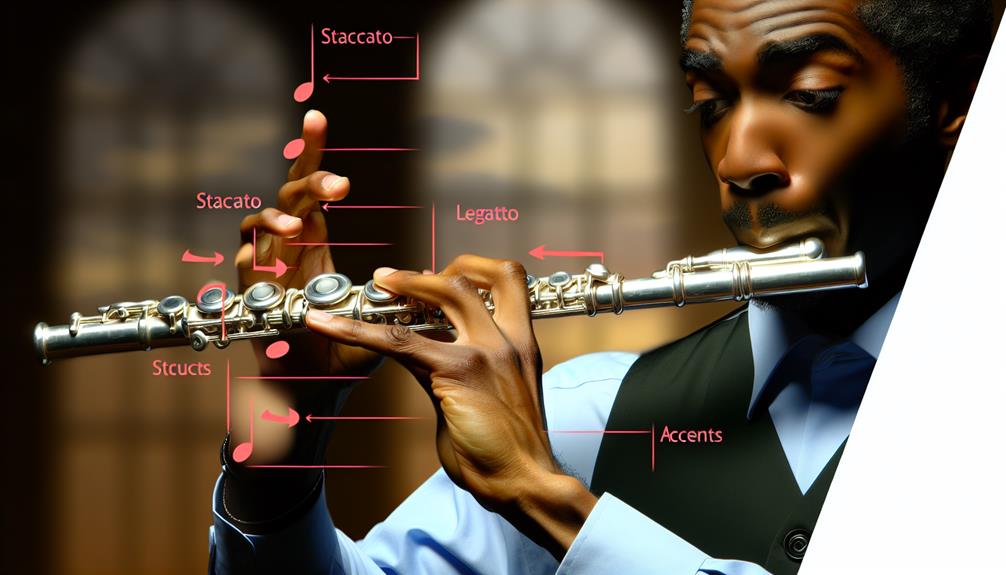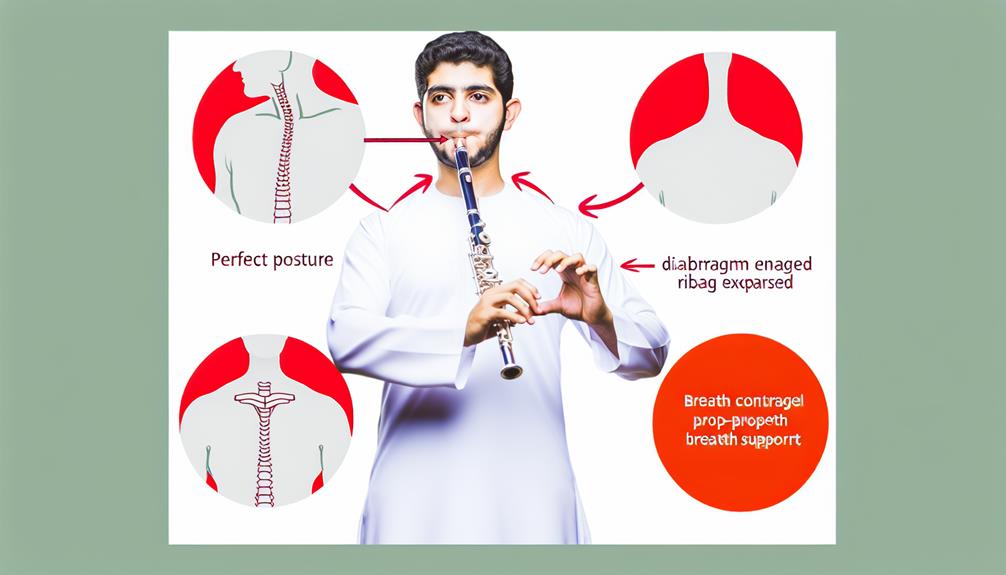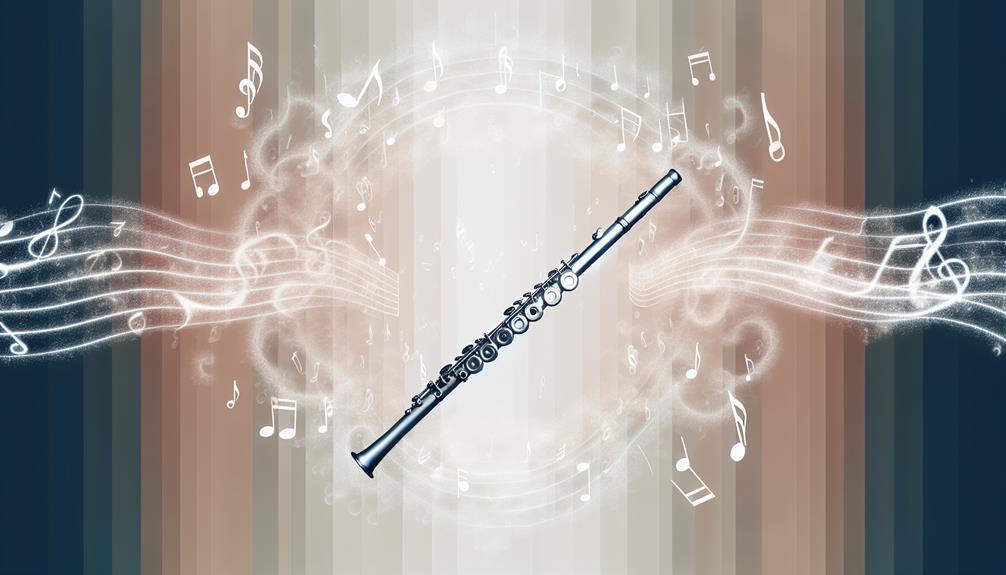Exploring the vast domain of flute repertoire tailored for different skill levels reveals a rich tapestry of musical opportunities awaiting flutists. From foundational exercises to intricate pieces demanding virtuosic prowess, the repertoire caters to a spectrum of abilities, offering challenges and growth prospects. As flutists navigate through these musical landscapes, they encounter not only technical obstacles but also artistic revelations that shape their musical journey. This intricate interplay between skill levels and repertoire choices raises intriguing questions about the transformative power of music and the endless possibilities for artistic exploration and development.
Key Takeaways
- Diverse repertoire enhances technical skills and artistic expression.
- Beginners focus on fundamental techniques and historical context.
- Recommended beginner pieces aid in skill development and musical understanding.
- Folk and traditional music enriches cultural influences and storytelling.
- Modern beginner pieces introduce contemporary styles and aid in skill progression.
Introduction
The repertoire a flutist chooses to play is an essential aspect of their musical development, impacting their growth and skill level. This guide aims to provide insights into the significance of embracing a diverse range of pieces and offers an overview of the content that will be explored in relation to flute repertoire for varying skill levels.
Importance of playing a diverse repertoire
Playing a diverse repertoire of music on the flute is vital for broadening a musician's skills and musical understanding. Musical exploration through a variety of pieces allows flutists to explore different styles, time periods, and cultural influences, enhancing their overall musicianship.
Skill development is another essential aspect impacted by repertoire variety. By tackling a diverse range of compositions, flutists can improve their technical abilities, such as tone production, articulation, and phrasing, ultimately becoming more versatile players.
Artistic expression is also enriched through playing a broad repertoire, as musicians are exposed to various emotions, moods, and musical interpretations, fostering creativity and individuality in their performances.
Additionally, engaging with a wide range of pieces contributes to learning diversity, enabling flutists to adapt to different musical challenges and expand their musical horizons. Incorporating a diverse repertoire into flute practice is fundamental for holistic musical growth and a well-rounded musical education.
Overview of what will be covered in this guide
In this guide, an in-depth examination of the flute repertoire tailored to various skill levels will be presented. The journey through this guide will encompass a thorough analysis of practice techniques aimed at enhancing flute playing abilities.
Skill progression will be a key focus, providing insights into how flutists can advance from one level to the next effectively. Repertoire selection will be thoroughly explored, offering guidance on choosing pieces that challenge but also resonate with the player's current proficiency.
Additionally, this guide will explore the world of musical exploration, encouraging flutists to broaden their horizons by experimenting with diverse genres and styles.
Chapter 1: Essential Pieces for Beginners
Chapter 1 of the 'Flute Repertoire for Different Skill Levels' explores essential pieces ideal for beginners.
This chapter delves into classical repertoire, recommending pieces by renowned classical composers suitable for novice flutists.
Additionally, it investigates folk and traditional music alongside modern compositions specifically designed for those starting their flute journey.
Classical Repertoire
Within the domain of classical flute repertoire, beginners are introduced to foundational pieces that serve as stepping stones for their musical journey. As novice flutists commence their exploration of classical music, they encounter a diverse array of compositions that not only refine their flute technique but also immerse them in the rich tapestry of musical expression. These essential pieces provide a solid groundwork for developing important skills in performance practice, musical interpretation, historical context, and music theory.
- Flute Technique: Beginner repertoire focuses on fundamental techniques such as tone production, breath control, and articulation.
- Performance Practice: Students learn how to apply performance etiquette, dynamics, and phrasing in classical music settings.
- Musical Interpretation: Understanding the composer's intentions and translating them into expressive performances is emphasized.
- Historical Context: Pieces are often situated within specific musical periods, allowing beginners to grasp the evolution of flute music.
- Music Theory: Basic theoretical concepts like rhythm, harmony, and form are integrated into the repertoire to enhance musical understanding.
Recommended pieces by classical composers
In this section focusing on essential pieces for beginners, simplified arrangements by classical composers provide an ideal starting point for novice flutists.
These compositions offer a foundational introduction to classical flute repertoire, enabling beginners to develop their technical skills and musical understanding.
Simplified arrangements for beginners
Simplified arrangements of classical music pieces provide a foundational repertoire for beginners learning to play the flute. These beginner resources offer a structured approach to mastering basic techniques and building a strong musical foundation.
The easy repertoire of simplified arrangements helps students ease into playing more complex pieces. Entry-level pieces are carefully selected to guarantee gradual progression and skill development.
- Structured approach to learning
- Building basic techniques
- Gradual progression in difficulty
- Strong musical foundation
- Skill development through practice
Folk and Traditional Music
The inclusion of popular folk songs in the flute repertoire for beginners offers a unique opportunity to explore traditional music styles. Understanding the techniques required to play folk music effectively can enhance a flutist's skills and musical expression.
Popular folk songs for beginners
Amidst the fundamental pieces essential for beginners to master in their flute repertoire lies a collection of popular folk songs that serve as an excellent introduction to traditional music styles. These pieces often feature:
- Folk song arrangements
- Beginner techniques
- Simple melodies
- Traditional tunes
- Easy repertoire suggestions
This selection provides a solid foundation for beginners to explore and develop their flute playing skills within a traditional music context.
Techniques for playing folk music
Exploring the nuances of playing folk music on the flute requires a deep understanding of traditional techniques and styles, essential for beginners delving into this rich musical genre.
Folk music interpretation involves conveying the soulful storytelling within the melodies. Traditional techniques like ornamentation and improvisation add depth.
Cultural influences, historical significance, and regional variations shape the distinct sounds found in different folk traditions, enriching the flute repertoire.
Modern Beginner Pieces
The exploration of modern beginner pieces in flute repertoire offers an opportunity for novice flutists to engage with contemporary compositions tailored to their skill level.
These pieces serve as valuable learning resources, providing aspiring musicians with sheet music that introduces them to the stylistic nuances of current musical trends.
Contemporary compositions for beginners
Within the domain of contemporary flute repertoire tailored for beginners, a selection of modern beginner pieces offers an entry point for novice players to explore and develop their musical abilities. These pieces address beginner challenges, reflect contemporary trends, aid in skill progression, showcase modern influences, and serve as excellent entry-level compositions.
They provide a foundation for beginners to understand and appreciate the nuances of contemporary flute music.
Learning resources and sheet music
In the world of modern flute repertoire tailored for beginners, a wide range of learning resources and sheet music are available to aid novice players in their musical journey.
These resources often include practice techniques, flute exercises, performance tips, sight-reading strategies, and music theory materials.
Such tools are essential for developing fundamental skills, fostering musical growth, and nurturing a strong foundation for aspiring flutists.
Chapter 2: Intermediate Flute Repertoire
The intermediate level of flute repertoire presents an opportunity for flutists to expand their classical music collection, including engaging with more intricate Baroque and Romantic pieces that demand a higher level of technical skill and musicality.
Additionally, this stage allows for exploration into popular and jazz repertoire, offering a diverse range of musical styles to broaden a flutist's performance capabilities and musical understanding.
Expanding Classical Repertoire
The intermediate flute repertoire offers a rich selection of pieces composed by classical masters, providing a bridge between beginner and advanced levels. These pieces often require a deeper understanding of musical interpretation, phrasing, and technical proficiency to convey the composer's intentions effectively.
As flutists progress through this repertoire, they develop essential skills such as breath control, articulation, and dynamic range to tackle more complex and demanding works in the future.
Intermediate pieces by classical composers
Within the domain of intermediate flute repertoire, classical composers have contributed a rich array of pieces that challenge and inspire the developing flutist.
- Intermediate challenges are present in works by Mozart and Haydn.
- Classical inspirations can be found in pieces by Beethoven and Schubert.
- Skill progression is evident in compositions by Bach and Handel.
- Composer exploration expands with pieces by Tchaikovsky and Debussy.
- Technical growth is fostered through works by Vivaldi and Mendelssohn.
Techniques to tackle more challenging works
When exploring the world of intermediate flute repertoire, developing a strategic approach to mastering more challenging works is essential for continued growth and proficiency. Practice strategies such as focused technical exercises, breaking down complex passages, and slow practice can aid in overcoming performance challenges.
Musical interpretation, utilization of advanced techniques, and artistic expression are paramount elements to convey the intended emotions and messages within these demanding pieces.
Baroque and Romantic Pieces
When exploring Baroque and Romantic pieces for intermediate flutists, it is imperative to examine key compositions from these distinct musical periods.
Understanding the nuances of interpretation and stylistic elements specific to each era is vital for delivering a compelling performance.
Key pieces from different musical eras
Throughout the history of flute music, key pieces from various musical eras have stood as pillars of the instrument's repertoire, showcasing the depth and diversity of compositions available to intermediate flutists.
- Historical context: Understanding the musical trends and societal influences of each era is essential.
- Influential composers: Recognizing the significant figures who shaped the flute repertoire.
- Performance techniques: Mastering the specific techniques required by pieces from different eras.
- Notable performances: Studying landmark performances that have left a lasting impact.
- Pedagogical approaches: Implementing effective teaching methods to navigate through diverse musical styles.
Interpretation and stylistic considerations
Exploring the nuances of interpretation and stylistic considerations is essential when delving into the intermediate flute repertoire encompassing Baroque and Romantic pieces.
Historical context shapes artistic interpretation, guiding flute techniques to convey musical expression authentically.
Performance dynamics play a pivotal role in capturing the essence of each era, demanding a balance between technical precision and emotive storytelling in these pieces.
Popular and Jazz Repertoire
The inclusion of arrangements of popular and jazz tunes in the intermediate flute repertoire provides students with exposure to diverse musical styles and fosters creativity in interpretation.
Additionally, guidance on improvisation and stylistic tips can enhance a player's ability to engage authentically with popular and jazz genres, further developing their musical skills and versatility.
This chapter offers a bridge for flutists to expand their repertoire beyond traditional classical pieces, encouraging exploration and growth in their musical journey.
Arrangements of popular and jazz tunes
Within the domain of intermediate flute repertoire, the incorporation of popular and jazz tunes in arrangements adds a dynamic and engaging dimension to the musician's repertoire. This blend allows for exploration of diverse styles and techniques such as jazz standards, pop arrangements, improvisation techniques, fusion styles, and popular covers.
These arrangements challenge flutists to adapt their playing to different genres, enhancing their musical versatility and creativity.
Improvisation and stylistic tips
Incorporating improvisation techniques and stylistic tips into intermediate flute repertoire enhances musicians' capacity to interpret and infuse popular and jazz tunes with individual creativity and expression.
By exploring improvisation techniques, flutists can explore stylistic nuances, fostering creative exploration and enhancing musical expression.
This artistic interpretation allows for a deeper connection to the music, showcasing the performer's unique voice within the popular and jazz repertoire.
Chapter 3: Advanced and Professional Pieces
Chapter 3 of advanced and professional flute repertoire opens the doors to major works that challenge even the most seasoned players. This section also explores the domain of contemporary and avant-garde music, pushing boundaries and offering a platform for innovative expression.
Additionally, advanced players can explore chamber music collaborations and tackle intricate orchestral excerpts to further refine their skills and expand their musical horizons.
Major Works for Advanced Players
The repertoire for advanced flute players encompasses significant concertos, sonatas, and solo pieces that demand a high level of technical proficiency and musicality.
These major works not only showcase the performer's virtuosity but also present unique challenges with regard to interpretation and execution.
Mastering these compositions requires a deep understanding of performance practice and a commitment to honing one's technical skills to achieve a professional level of artistry.
Important concertos, sonatas, and solo pieces
Exploring the advanced and professional repertoire for flutists reveals a rich tapestry of important concertos, sonatas, and solo pieces that showcase virtuosity and musical depth.
- Flute concertos, analysis
- Sonatas, historical context
- Solo pieces, performance tips
- Interpretation challenges, solutions
- Repertoire selection, personal preferences
Performance practice and technical challenges
Delving into the intricacies of performance practice and maneuvering technical challenges in advanced flute repertoire necessitates a meticulous approach that combines artistry with technical precision. This level demands mastery of performance techniques, including breath control and expressive playing with nuanced dynamics.
Additionally, players face articulation challenges and must navigate complex fingerings. Tone production and phrasing are essential, as is the ability to showcase musical interpretation through subtle tempo variations.
Contemporary and Avant-Garde Music
In the domain of advanced flute repertoire, contemporary and avant-garde music showcases modern compositions that often incorporate extended techniques, pushing the boundaries of traditional flute playing. Understanding and mastering these pieces require a deep exploration of the innovative sounds and structures they present, challenging players to expand their technical and interpretive skills.
To navigate this intricate landscape of contemporary flute music, aspiring flutists can benefit greatly from utilizing a diverse array of resources tailored to aid in the learning and interpretation of these complex compositions.
Modern compositions and extended techniques
Within the domain of flute repertoire for advanced and professional players, the exploration of modern compositions and utilization of extended techniques play a significant role in pushing the boundaries of traditional performance practices.
- Avant-garde elements challenge conventional norms
- Contemporary techniques offer new sonic possibilities
- Modern compositions incorporate diverse influences
- Extended techniques in flute repertoire expand expressive capabilities
- Innovative approaches facilitate the creation of new musical expressions
Resources for learning contemporary pieces
The progression towards mastering modern and cutting-edge flute pieces requires a thorough understanding of the resources available for learning and interpreting these intricate compositions.
Modern techniques, contemporary resources, and extended techniques play pivotal roles in shaping the interpretation of avant-garde flute music.
Utilizing effective learning strategies and accessing diverse sheet music sources are essential for flutists aiming to explore the intricacies of contemporary repertoire and excel in the domain of avant-garde music.
Chamber Music and Orchestral Excerpts
Chapter 3 of advanced and professional flute repertoire delves into the intricate world of chamber music and orchestral excerpts. These pieces are crucial for flutists looking to stand out in auditions and ensemble performances.
Notable works and key excerpts featured in this chapter offer a challenging yet highly rewarding experience for advanced players.
Key excerpts for orchestral auditions
In exploring advanced and professional flute repertoire, a critical focus lies on the meticulous selection and mastery of key orchestral excerpts essential for auditions.
- Audition preparation: Understanding the nuances of each excerpt.
- Mock auditions: Simulating real audition conditions for practice.
- Performance techniques: Implementing breathing and phrasing techniques effectively.
- Orchestra auditions: Maneuvering challenging passages with precision.
- Practice strategies: Developing a systematic approach to mastering excerpts.
Repertoire for chamber ensembles
Exploring the intricate interplay of advanced flute repertoire within chamber ensembles examines the nuanced dynamics and collaborative artistry essential for high-level musical performances. When selecting repertoire for chamber ensembles, considerations like balancing voices and honing chamber ensemble skills are paramount. Successful performances hinge on seamless ensemble dynamics and the ability of musicians to engage in collaborative performances effectively. The table below illustrates key elements in mastering chamber music.
| Chamber Ensemble Skills | Repertoire Selection |
|---|---|
| Listening attentively to other musicians | Choosing pieces that highlight individual strengths within the ensemble |
| Communicating effectively during rehearsals | Selecting diverse styles to expand musical versatility |
| Understanding and adapting to different playing styles | Ensuring pieces challenge but do not overwhelm the ensemble |
| Valuing every member's contribution | Incorporating pieces that encourage ensemble cohesion |
Chapter 4: How to Choose Pieces That Will Help You Grow as a Flutist
When selecting pieces to enhance your flute playing skills, it is important to first assess your current level of proficiency. Setting clear repertoire goals based on your strengths and areas needing improvement can guide your selection process effectively.
Building a well-rounded repertoire that includes a mix of technical challenges and musical styles will provide a thorough platform for growth as a flutist.
Assessing Your Current Skill Level
Evaluating your current skill level as a flutist is an essential step in selecting repertoire that will challenge and enhance your abilities.
Techniques for self-evaluation, such as analyzing your tone quality, intonation, and technical agility, can provide valuable insights into areas for improvement.
Seeking feedback from experienced teachers or mentors can further guide your repertoire choices towards pieces that will facilitate growth and development in your flute playing.
Techniques for self-assessment
Understanding one's proficiency level in flute playing is essential in selecting pieces that align with personal growth as a musician.
To accurately assess your skill level, consider the following techniques:
- Utilize assessment techniques like recording yourself playing
- Implement self-evaluation strategies to identify strengths and weaknesses
- Regularly track your progress to measure improvement
- Engage in skill level assessment exercises to gauge technical abilities
- Apply personal development techniques to enhance overall musicianship.
Seeking feedback from teachers
In the process of selecting flute repertoire that aligns with your musical growth, seeking feedback from experienced teachers plays a crucial role in accurately gauging your current skill level. Teachers employ various teaching strategies and feedback methods to engage students, track progress, develop curricula, plan lessons, assess skills, set goals, and provide opportunities for peer collaboration and workshops. The table below illustrates these aspects in more detail:
| Teaching Strategies | Feedback Methods |
|---|---|
| Student Engagement | Progress Tracking |
| Curriculum Development | Lesson Planning |
| Skill Assessment | Goal Setting |
| Peer Collaboration | Workshop Opportunities |
Setting Repertoire Goals
When selecting repertoire goals for flute playing, it is vital to choose pieces that target specific technical and musical objectives. This guarantees that your practice is focused and purposeful, leading to tangible improvement.
Additionally, striking a balance between challenging yourself and finding enjoyment in the music will sustain your motivation and foster growth as a flutist.
Choosing pieces that address specific technical and musical goals
An essential aspect of advancing as a flutist is selecting repertoire that aligns with specific technical and musical objectives to facilitate growth and development.
- Technical exercises: Incorporate etudes or scales to improve technique.
- Musical interpretation: Choose pieces that challenge your expressiveness.
- Practice strategies: Develop a structured practice routine for efficient progress.
- Performance tips: Focus on stage presence and managing performance anxiety.
- Repertoire selection: Diversify your repertoire to broaden musical skills.
Balancing difficulty with enjoyment
To progress effectively as a flutist, it is imperative to strike a balance between the level of difficulty in the chosen repertoire and the enjoyment derived from playing these pieces. Skill development hinges on selecting pieces that challenge but also engage.
Motivation factors play an important role in musical growth, therefore strategies for skill advancement must consider interest retention alongside overcoming technical challenges through a thoughtful difficulty progression in repertoire selection.
Building a Balanced Repertoire
When constructing a balanced flute repertoire, it is crucial to contemplate the combination of different genres and styles to enrich your musical versatility.
By planning for long-term repertoire development, flutists can guarantee steady progress and growth in their skills.
Selecting pieces that challenge various aspects of playing will assist flutists in expanding their technical abilities and musical interpretation.
Combining different genres and styles
In the domain of flute repertoire, the amalgamation of various genres and styles serves as a pivotal strategy for advancing one's proficiency as a flutist. This fusion of styles allows for cross-genre exploration, genre blending, musical diversity, and style fusion, enhancing the depth and breadth of a flutist's musical capabilities.
Planning long-term repertoire development
Developing a thorough long-term repertoire plan is crucial for flutists seeking to enhance their musical growth and proficiency over time.
Repertoire progression should be carefully considered, balancing pieces that challenge and expand skill development.
Long-term planning guarantees a structured approach to musical growth, incorporating a diverse range of repertoire to foster a well-rounded flutist.
This strategic selection of pieces plays a vital role in the flutist's overall musical development.
Conclusion
The conclusion of this discourse on flute repertoire for varying skill levels encapsulates the essence of selecting pieces to foster growth in musicianship.
By providing a summary of key points, readers can reflect on the significance of diverse repertoire in honing their craft.
Moving forward, the encouragement to explore a wide range of musical compositions serves as a gateway to expanding one's musical library and embracing new challenges.
Summary of key points
Upon reviewing the various levels of flute repertoire, it becomes evident that each skill level offers unique challenges and opportunities for musical growth.
- Skill Progression: Advancing through flute repertoire allows players to develop and refine their technical abilities and musical understanding progressively.
- Repertoire Selection: Choosing pieces appropriate to one's skill level is vital for continual improvement and avoiding frustration.
- Technical Challenges: Each level of repertoire introduces new technical challenges that push flutists to expand their skills and techniques.
- Musical Interpretation: Different levels of repertoire require varying degrees of musical interpretation, encouraging players to explore further into the emotional and artistic aspects of music.
- Performance Opportunities: Engaging with repertoire at different skill levels provides opportunities for flutists to showcase their progress and talents through performances, whether in a formal setting or among peers.
Encouragement to explore diverse repertoire
Exploring a diverse range of repertoire in flute playing not only broadens a musician's musical horizons but also cultivates a versatile and adaptable skill set essential for growth and artistic development. Encouraging flutists to immerse themselves in a wide array of musical choices can greatly impact their skill level progression, leading to a deeper understanding of music and enhanced performance abilities. By embracing repertoire variety, individuals engage in a journey of musical exploration and development, refining their interpretative skills and fostering a deeper connection with their instrument.
| Benefits of Repertoire Exploration | Examples of Diverse Repertoire |
|---|---|
| 1. Enhanced musical understanding | 1. Baroque sonatas |
| 2. Improved technical proficiency | 2. Contemporary flute pieces |
| 3. Increased stylistic versatility | 3. World music arrangements |
Diversifying one's repertoire not only provides a platform for personal growth but also instills a sense of creativity and adaptability, essential qualities for a well-rounded musician. Embracing a wide range of musical genres equips flutists with the tools necessary to navigate the ever-evolving landscape of music, fostering continuous growth and artistic evolution.
Next steps for expanding your musical library
Expanding one's musical library requires strategic selection and thoughtful contemplation of repertoire to further enhance artistic proficiency and broaden musical understanding. As flutists progress in their musical journey, it is essential to continue challenging themselves with diverse pieces that push boundaries and foster growth.
Here are some key aspects to ponder for expanding your musical library:
- Advanced Techniques: Select repertoire that introduces complex techniques such as multiphonics, flutter tonguing, or extended techniques to refine your skillset.
- Musical Challenges: Choose pieces that present unique musical challenges like intricate rhythms, unconventional time signatures, or demanding phrasing to enhance your musicality.
- Performance Growth: Opt for repertoire that stretches your performance abilities, allowing you to explore different styles and genres to evolve as a well-rounded musician.
- Skill Development: Focus on pieces that target specific areas for improvement, whether it be tone production, articulation, or dynamic control to elevate your playing.
- Repertoire Expansion: Continuously add a variety of pieces from different time periods and composers to broaden your musical repertoire and deepen your understanding of diverse musical styles.
Additional Resources
When expanding one's flute repertoire, having access to recommended sheet music collections, online databases, and community recommendations can greatly aid in the exploration of diverse musical pieces. These resources provide a wide range of compositions suitable for different skill levels, allowing flutists to discover new pieces and broaden their musical horizons.
Recommended sheet music collections
An extensive array of sheet music collections tailored to various skill levels can greatly enhance a flutist's repertoire. When selecting sheet music collections, it is vital to take into account the incorporation of diverse flute techniques, musical interpretation, and effective practice strategies.
The following recommended sheet music collections cater to flutists looking to enrich their repertoire with pieces that challenge and inspire:
- *'Selected Studies for Flute'* by French flutist Marcel Moyse offers exercises focusing on tone production and articulation, ideal for refining flute techniques.
- *The Flute Music by French Composers* compilation provides a rich selection of pieces emphasizing musical interpretation and stylistic nuances.
- *The Ultimate Flute Sheet Music Collection* curated for varying skill levels includes classical, contemporary, and etude pieces to enhance practice strategies.
- *Solo Pieces for Flute and Piano* by various composers offers a range of performance tips and opportunities for solo exploration.
- *The Flutist's Collection of Etudes* by renowned flutist Taffanel and Gaubert focuses on developing technical proficiency and performance skills.
Online databases and music libraries
Online databases and music libraries provide a vast repository of sheet music and resources for flutists seeking to expand their repertoire and access a diverse range of musical compositions.
These online resources, such as music databases and digital collections offered by various music libraries, play an important role in assisting musicians of all skill levels in discovering new pieces and exploring different genres.
Flutists can access sheet music from classical to contemporary works through online platforms, enabling them to broaden their flute repertoire greatly.
Community recommendations and playlists
Curated community recommendations and playlists offer valuable insights into diverse flute repertoire selections, catering to musicians seeking inspiration and a varied musical experience. Engaging with the community through playlist sharing can not only broaden one's musical horizons but also provide a platform for skill progression and collaborative learning.
Here are some key benefits of utilizing community recommendations and playlists:
- Diverse Repertoire Suggestions: Community-curated playlists often encompass a wide range of musical styles and composers, introducing flutists to new pieces they may not have encountered otherwise.
- Skill Progression Opportunities: By exploring playlists tailored to different skill levels, musicians can challenge themselves with progressively complex pieces, aiding in their growth and development.
- Community Engagement: Participating in playlist sharing fosters a sense of belonging within the flute community, encouraging connections with fellow musicians and sharing of experiences and insights.
- Collaborative Learning Environment: Collaborating on playlists or discussing recommended pieces with peers can enhance learning experiences, offering different perspectives and interpretations on repertoire selections.
Conclusion
To sum up, the flute repertoire for different skill levels offers a rich tapestry of musical pieces that cater to flutists' growth and development. By selecting pieces that challenge and inspire, flutists can commence on a journey of musical exploration and advancement.
Just as a skilled artist uses various colors to create a masterpiece, flutists can utilize the diverse repertoire to enhance their skills and achieve greater musical heights.




